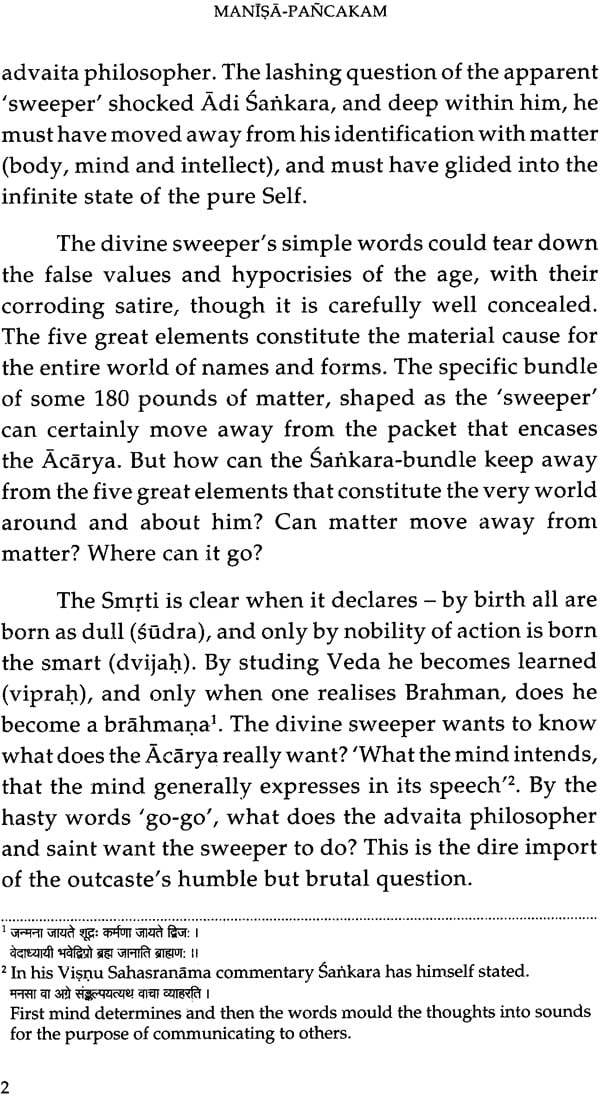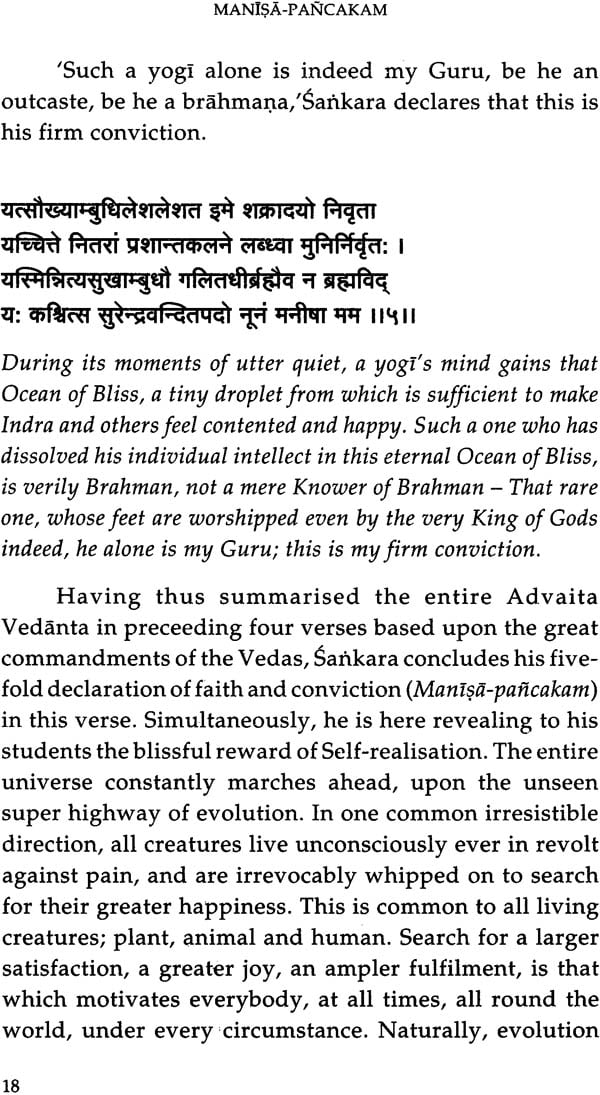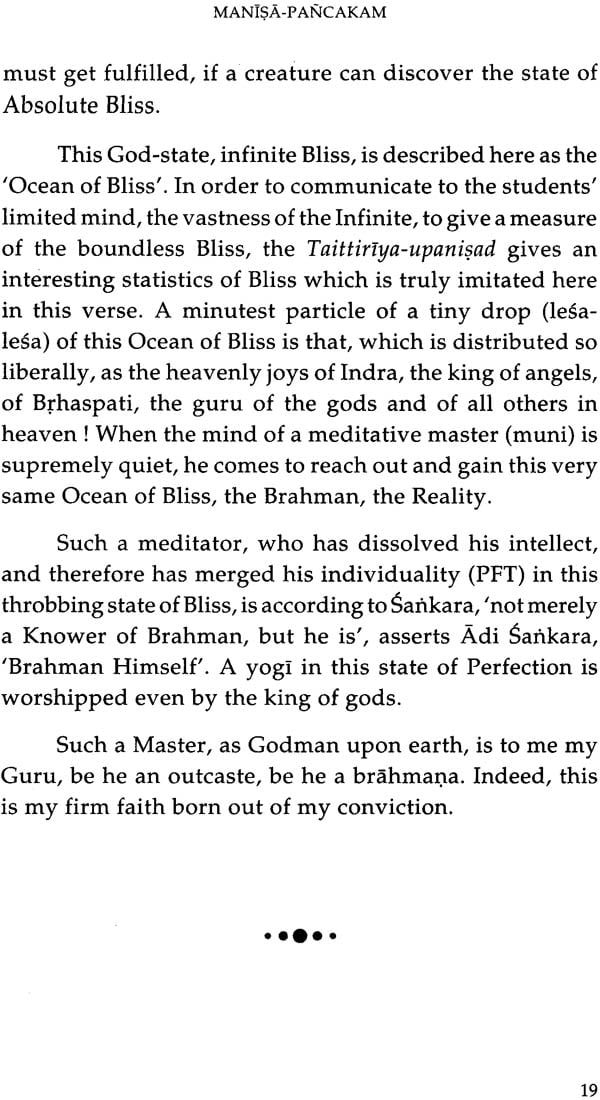
Manisa-Pancakam (Sanskrit Text, English Translation and Detailed Explanation)
Book Specification
| Item Code: | NAH312 |
| Author: | Swami Chinmayananda Saraswati |
| Publisher: | CENTRAL CHINMAYA MISSION TRUST |
| Language: | Sanskrit Text with English Translation |
| Edition: | 2016 |
| ISBN: | 9788175972742 |
| Pages: | 32 |
| Cover: | Paperback |
| Other Details | 8.5 inch x 5.5 inch |
| Weight | 50 gm |
Book Description
Preface to the Third Edition
Adi Sankaracarya’s hymns (stotras) contain pearls of wisdom for practical guidance of humanity like those of other eminent and enlightened saints and seers. Their significance goes a long way towards quicker spiritual evolution of the seekers.
The word ‘manisa’ in Sanskrit means conviction and pancakam means a collection of five slokas. Manisa- Pancakam is thus a short stotra by Adi Sankaracarya - a five-fold declaration of faith and conviction.
The traditional story behind this Paficakam is detailed in the Introduction. The import of this stotra lies in its revelation that our identification with the body and mind is so strong that sometimes, in careless moments, even a Man of perfection like Acarya Sankara, unwittingly comes to live mechanically the existing customs and values of his times.
We are pleased to bring out the revised edition of this book to meet the constant demand of serious students and sincere seekers. Our heartfelt thanks to Brni. Nivedita, Ramona Singh and Anjali Singh for the Cover design.
Introduction
The saddest pages in the history of a nation are those that describe the cultural break-up in its community. Generally the decadent culture dissipates itself to extinction. However, a culture that has an intrinsic vitality is sure to throw up a Master who has both the wisdom and the dexterous enthusiasm to halt the rupture, and gather and drive back the community into an era of cultural revival and national resurrection. Hinduism was at a very critical juncture in the middle of the 7th century. Orthodox Hinduism, with its elaborate and confusing ritualism could no longer inspire the masses; even the rich who could conduct these expensive yajnas and yagas, did not feel any sense of participation. Buddhism had broken down into endless groups, each fighting with the others, and the enchantment of direct thought and simple ideals got lost in the confusing medley of their involved dialectics and noisy argumentations.
It was at such a smouldering era of total decadence and endless confusions, that we had the timely rise of a fresh national hope in a young Kerala brahmana, Adi Sankara. And soon this hope of giving Hindus a clear philosophy, beaconing them back to the Upanisads and raising the general consciousness of the entire nation was fulfilled. With the advaita philosophy, stemming forth from the gushing ‘sources of knowledge’, the Upanisads, Sankara could reclaim the hopes of the community from the cobwebs of ritualism and give to the Hindus, a peep into the wholesome beauty of their own ancient culture.
Perfected masters are the sacred instruments through which the Lord functions to maintain the universal rhythm and keep the world a healthy field for the onward march of evolution. The Infinite Will can readily play itself through such man of total identification with the Lord, and they alone are, therefore, the most competent instruments for the Universal Law to accomplish its divine purpose.
To artists, their instruments are the most precious possessions. They are always well cared for, trimmed, sharpened, cleaned and kept ever tuned-up with diligent attention and soothing love. Lord jagadisvara also never spares his chosen workers. Adi Sankara too was not to be spared from this Cosmic-law! He too has to be re-strung and re-tuned from time to time. The traditional story behind this Pancakam is rather skeletonal. One day Adi Sankara along with his disciples, Padmapada and others, after a cool and refreshing bath in the Ganga at Kasi, was on his way to the sacred temple of Sri Visvanatha. Everyone is a creature of the powerful social values of his age. Sankara saw a dirty sweeper, with his professional instrument under his arms, coming along. The brahmana in the Acarya, coloured by the traditional custom, prevalent at that time, cried ‘go go’ - ‘move move’.
Even in a Man of prefection, there are careless moments when he gets thrown out, and comes to function identifying with his body and mind. With his individualistic ego, he experiences and asserts the plurality, and at such moments he may unwittingly come to live mechanically, the exisiting customs and general values of his times-be they good or bad, be they right or wrong.
The refreshing waters of the Ganga intensifies the body-consciousness in the bather, and perhaps in that mood when the master was marching out towards the temple-the mere external symbol of the inexhaustive springs of Consciousness within-for no fault of his, unwittingly he happend to step, for the moment, into a lower state of Consciousness. In the eyes of the Lord, even this slip is inexcusable in His chosen messenger!
Hailed as the second Swami Vivekananda, Pujya Gurudev Swami Chinmayananda (1916-1993) has left a great legacy behind for mankind. On realising the true purpose of life, he worked tirelessly and with tremendous energy for more than four decades to spread the message of Vedanta. A great orator, writer, leader, patriot and spiritual giant, he is one of the finest representatives of Indian spiritual heritage. The sprawling worldwide organisation of Chinmaya Mission carries on the torch lit by this great Saint.









